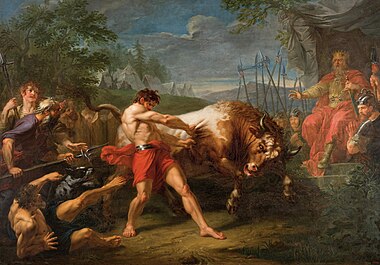| Testing the strength of Jan Usmar | |
|---|---|
 | |
| Artist | Grigory Ugryumov |
| Year | 1796 (1797?) |
| Medium | Oil on canvas |
| Dimensions | 283 cm × 404 cm (111 in × 159 in) |
| Location | State Russian Museum, Saint Petersburg |
Testing the strength of Jan Usmar is a painting by the Russian artist Grigory Ugryumov (1764–1823), completed in 1796 (or 1797). It is held in the State Russian Museum in St Petersburg (inventory Zh-5052). The dimensions of the painting are 283 × 404 cm.[1][2][3] The longer title of the painting is also used, namely, "Prince Vladimir's testing of the strength of the Russian bogatyr Jan Usmar before his duel with the Pechenegian bogatyr."[4]
The plot of the film is based on a chronicle story of the Battle of 992, in which the Old Russian army of Prince Vladimir Svyatoslavich emerged victorious against the Pechenegs. Before the battle began, it was necessary to find a warrior who would be capable of matching the Pechenegian bogatyr in combat. He turned out to be the son of a Kyiv leatherworker, Jan Usmar, who with honour passed the test set for him - with his hands he stopped the running bull by tearing off a piece of leather.[3]
In July 1797, following the completion of the painting by Ugryumov, it was approved by the extraordinary meeting of the Imperial Academy of Arts, and the artist was awarded the title of Academician.[5] The canvas remained in the collection of the Academy of Arts for a considerable period, and in 1923 it was transferred to the State Russian Museum.[1]
In the estimation of art historian Alla Vereshchagina, Testing the strength of Jan Usmar represents the pinnacle of Ugryumov's oeuvre, despite the fact that this painting is comparatively deficient in historical and ethnographic detail in comparison to some of the artist's other works.[6] Art historian Alexei Savinov noted the effective composition of the canvas, which combines a dynamic group of warriors on the left, Prince Vladimir on the right, and Jan Usmar with an enraged bull in the centre.[7] According to art historian Nonna Yakovleva, "mature mastery and inspired impulse not only distinguish 'Jan Usmar' among Ugryumov's works, but also give it a special place in the history of Russian art".[8]
- ^ a b State Russian Museum catalogue (1980, pp. 324–325)
- ^ State Russian Museum catalogue, vol. 1 (1998, p. 166)
- ^ a b "Ugryumov G. I. Ispytaniye sily Yana Usmarya. 1796 (1797?)" Угрюмов Г. И. Испытание силы Яна Усмаря. 1796 (1797?) [Ugryumov G. I. Testing the power of Jan Usmar. 1796 (1797?)]. State Russian Museum — virtual branch — www.virtualrm.spb.ru (in Russian). Archived from the original on 2016-03-04. Retrieved 2015-09-25.
- ^ Moleva (1991, p. 59)
- ^ Yakovleva (1982, p. 48)
- ^ Vereshchagina (1973, p. 23)
- ^ Savinov (1961, pp. 188–189)
- ^ Yakovleva (1982, p. 46)